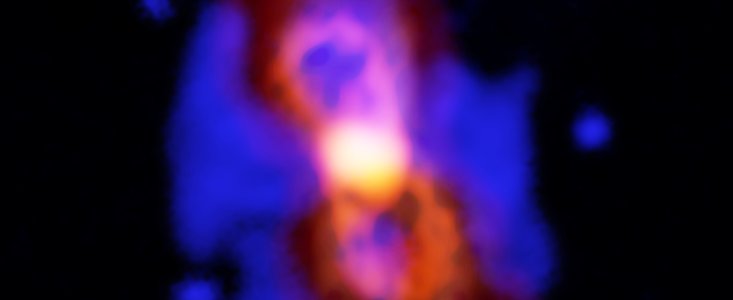Polish Involvement with ESO

Composite image of CK Vulpeculae, the remains of a double-star collision that launched radioactive molecules into space. (Credit: ALMA (ESO/NAOJ/NRAO), T. Kamiński; Gemini, NOAO/AURA/NSF; NRAO/AUI/NSF, B. Saxton)
Poland joined ESO as a Member State on 8 July 2015. While this makes Poland one of ESO’s most recent Member States, the country has contributed in ESO projects in numerous ways, including through having its community of scientists participate in important discoveries with ESO’s telescopes.
Poland currently contributes 3.04% of ESO’s revenue (2021 contribution), worth 5 838 000 EUR.
As of mid 2022, there are 14 Polish nationals employed at ESO, 12 in Germany and two in Chile. Furthermore, ESO has awarded four studentships, eight fellowships and one internship to Polish nationals since 2004.
Poland is represented in the various ESO governing and advisory bodies by astronomers and policy experts; the current Polish representatives of ESO’s various committees with national representation can be found here.
The ESO Science Outreach Network (ESON) includes Polish representatives who act as ESO’s media and outreach local contacts.
Here follows some information about Polish involvement with ESO.
Discoveries by Poland-based astronomers using ESO telescopes
Polish researchers and those based at Polish institutions have been involved in important discoveries using ESO facilities. These include
- Polish astronomer Tomasz Kamiński and Romuald Tylenda of the Polish N. Copernicus Astronomical Center who led a team of astronomers that made the first definitive detection of a radioactive molecule in interstellar space. The observations, done with the help of ALMA, revealed that the radioactive isotope of aluminium was dispersed into space after the collision of two stars that left behind a remnant known as CK Vulpeculae.
- A team in Poland that observed comet 2I/Borisov, the first alien comet to visit our Solar System, using the X-shooter spectrograph on ESO’s Very Large Telescope (VLT). They found that 2I/Borisov’s cold atmosphere contains gaseous nickel, the first time a heavy metal has been detected in an interstellar comet.
- Marcin Kiraga from the Warsaw University Observatory who was part of a team that found an Earth-mass exoplanet around Proxima Centauri, the nearest star to the Solar System.
- Roberto Mignani at the University of Zielona Góra who led a European team who used ESO’s VLT to observe a neutron star. They found the first observational indications of a strange quantum effect, first predicted in the 1930s.
Polish involvement in ESO instruments and telescopes at ESO sites
As a recently joined Member State, Polish involvement in instrument consortia is mostly limited to future projects, such as ESO’s upcoming Extremely Large Telescope (ELT). Polish scientists and engineers, coordinated by the Nicolaus Copernicus University in Toruń, are participating in the design of the ANDES spectrograph for the ELT. ANDES will study astronomical objects with unprecedented sensitivity.
Additionally, Poland will be a member of the future CTA ERIC, the European Research Infrastructure Consortium, that will construct and operate the Cherenkov Telescope Array (CTA). The CTA will be a ground-based observatory for very high energy gamma-ray astronomy. It will consist of two arrays of dishes, a southern-hemisphere array hosted at ESO’s Paranal Observatory and a northern array on the island of La Palma, Spain. ESO will also be a member of the CTA ERIC and is represented in the council of the CTA. Furthermore, the University of Warsaw was involved in an ESO-funded geotechnical investigation and structural study for the CTA-South site.
Polish industry and technology contributions to ESO
Despite Poland being a recent ESO Member State, its industry has already been awarded important ESO contracts. For example, Solaris Optics S.A. was contracted to provide mirrors for the auxiliary telescopes of ESO’s Very Large Telescope Interferometer, while AIES Sp. Z o.o. was awarded a contract for a module for an ESO detector controller.
Polish industry contributions to the ELT
In addition to participating in the instrument consortium for ANDES, industry in Poland has also contributed to ESO’s future ELT. For example, Solaris Optics S.A. was awarded a contract to provide mechanical components and glass-ceramic samples for the telescope.